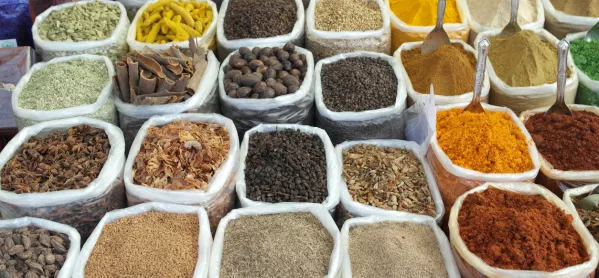4 ways to use the senses to boost EYFS vocabulary

Over my years working internationally, I have seen that the strongest motivation for young children lies within experiential, active learning that puts learning in context.
One way I do this a lot if with language. As the majority of children that I work with have very basic English using active learning can be a great way to grow vocabulary beyond using objects and pictures.
That’s why this year we developed experiences that also incorporated the other four senses in addition to sight to our teaching of Early Years EAL.
The unit followed on from our work on body parts, so the children were aware the functions of eyes, hands, ears, nose and mouths. We developed a program of inquiry for each sense which lasted for one week.
During the inquiry we:
- Limited the new vocabulary to two words per session alongside a phrase. For example, we would teach the taste descriptor ‘salty/spicy’ with a salty and a spicy crisp.
- Then we would teach a phrase in the first session to be used that week, and beyond, such as ‘I like/dislike’.
- In each consecutive session of that week, we would add two further words in context (such as sweet/sour) with the first phrase.
- If we felt the original phrase was embedded, as the majority of the children were using it naturally and frequently inside and outside of direct teaching, we would add one additional phrase.
This way we gradually built up language and phrases. This process really supported the children to embed the learning. Here is how we did it for each area:
1. Exploring taste
When exploring taste, we created experiences whereby they tasted spicy crisps, lemon, mochi, sugar and pure salt. Along with naming the taste we taught key phrases, as discussed, a further phrase we added was ‘I like to eat/I don’t like to eat…’
We explored adjectives as we ate the food, describing it as ‘crunchy’, ‘soft’, ‘smooth’ and ‘salty/spicy’. We worked to develop their vocabulary beyond ‘yummy’ to use descriptions such as ‘tasty’ and ‘delicious.’
2.Exploring smell
The following week the children smelt different foods as well as items, such as vinegar and perfume, stinky tofu and mint. We continued to use the phrases from the previous week, such as like and dislike.
We extended the phrases to ‘the (item) smells (nice/horrible/strong)’.
Further, when the children could both smell and taste a food, we created compound spoken sentences such as ‘…it smells nice but tastes too spicy’.
3. Exploring texture
We felt surfaces such as smooth hardwood; scratchy, rough sandpaper and a spiky cactus!
The children really enjoyed passing a cactus around in a small group and daring one another to touch it. Again, this experience generated lots of descriptive language, but also language which was purely organic and applied in context, such as, ‘be careful’ and ‘touch gently.’
The children had opportunities to touch unusual substances in our continuous provision which included ‘gloop’ (cornstarch and water) and use practise vocabulary such as ‘soft’, ‘cold’, ‘wet’ and as squished the cornstarch mixture, they could describe it as ‘hard’.
They also experienced playing with slime (a mixture using glue) whereby we could add in new language such as ‘slimy’, ‘gooey’ in addition to the words they knew, such as ‘wet’ and ‘cold’.
We compared this material with playdough and discussed how it wasn’t as stretchy or moldable. Again, as the children tried stretching and forming the slime with molds, they could see for themselves the properties of these materials as they used the language.
My plan for next year is also to include sensory activities with their feet, as I think they will love it - such as standing on grass, in jelly, mud, water and foam.
4. Exploring sound
This work took place during the time we were working on the Phase 1 Letters and Sounds phonics program.
This program was excellent at ‘tuning’ the children into sound. We identified sounds first together using interactive whiteboard games and hidden items I kept in a box.
Then they had a turn at creating their own, with body procession, voice sounds and instruments. Any time we walked around the school; we took a ‘sound walk’. This was part of our routine and took no extra time, but helped the children identifying environmental noises such as birds, construction noises, children talking, and traffic noise.
When incorporating these methods, engagement and excitement are visible for all to see. Children often return to these activities again and again.
The success of this method can be seen months later, in many contexts. I ask my class whether they like or dislike something, if a sound is noisy or quiet and if a smell is beautiful or horrible. Not only can they answer these questions but they use the language in their own discussions.
Jess Gosling is a teacher at the Taipei European School. She can be contacted via her website or Twitter @JessGosling2
You need a Tes subscription to read this article
Subscribe now to read this article and get other subscriber-only content:
- Unlimited access to all Tes magazine content
- Exclusive subscriber-only stories
- Award-winning email newsletters
Already a subscriber? Log in
You need a subscription to read this article
Subscribe now to read this article and get other subscriber-only content, including:
- Unlimited access to all Tes magazine content
- Exclusive subscriber-only stories
- Award-winning email newsletters